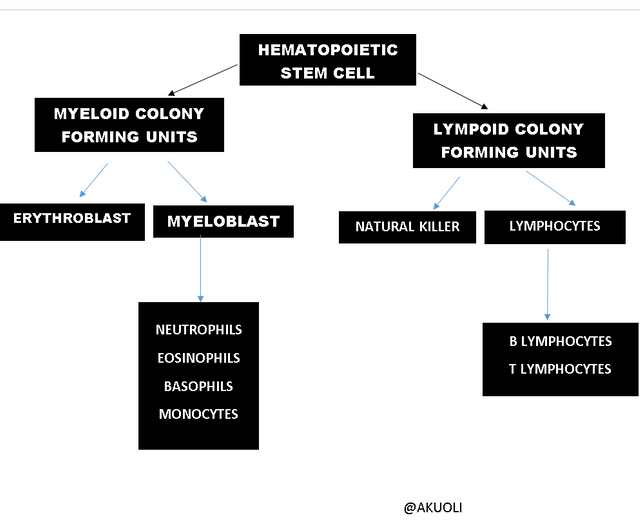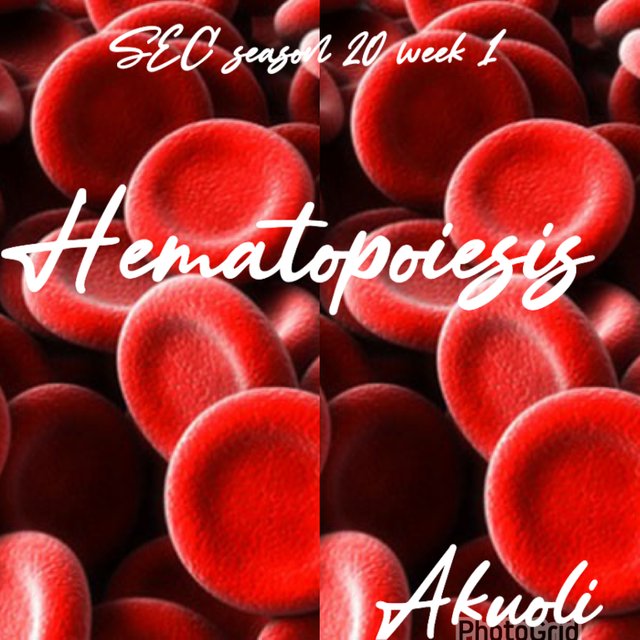SEC S20W1 || Hematopoiesis - Module 1
Anatomy and function of hematopoietic organs (2 points)
Anatomy: this is located in the cavities of long bones i.e femur, humerus and other flat bones i.e sternum and pelvis.
Function: it is the dominant site for hematopoiesis in adults however it starts blood production in the 4th month, After 5th month, it is the primary site of hematopoiesis. It functions throughout the life span of an individual.
Anatomy: the liver in fetal life is located in the right upper quadrant of the fetal abdomen whilst the spleen is found in the left upper quadrant of the fetal abdomen.
Function: they are the sites where the hepatic phase of hemopoiesis occurs. The Liver becomes the major organ by the 2nd month gradually replacing the yolk sac, Production by the liver goes down within 1-2 weeks of delivery
Anatomy; the yolk sac is found outside the still developing embryo.
Function: Is the site where blood cells are produced in the early stages of development. Occurs mostly during the first 2-8 weeks of life and Stops at 8 -10 weeks of gestation
ANATOMY: Lymph nodes are scattered in the body along lymphatic vessels whilst the spleen is found upper left quadrant of the abdomen
FUNCTION; perform extramedullary hematopoiesis.and helps in the maturation of B cells, T cells and NK cells.

Medullary Hematopoiesis vs Extramedullary Hematopoiesis (2 points)
It refers to the process of blood cells production in the bone marrow. The bone marrow forms a suitable environment for stem cell survival, self - renewal and formation of differentiated progenitor cells so it is the primary type of hematopoiesis in healthy adults
This is a type of blood cells production which occurs outside the bone marrow in post fetal life. It usually takes place in the liver and spleen. This is not the normal way of blood production so it happens in a pathological conditions such as:
When the bone marrow becomes dysfunctional.
Aplastic anemia.
Hemolytic anemia requiring the body to produce more blood to compensate
If extramedulary hemopoiesis develops, the liver and spleen are enlarged

Make a diagram of Hematopoiesis and explain it in your own words. (2 points)
Blood production in humans is a continuous process because there is supposed to be a balance as blood cells die out everyday. Blood cells production is triggered by various cytokines and mechanisms eg: erythropoietin, interleukins etc. when these signals are sent out to the bone marrow for blood production to commerce the bone marrow now produces Hematopietic stem cells. These hematopoietic stem cells are multipotent in the sense that they can differentiate to different cell lines. The hematopoietic stem cells then differentiate to two lineages called myeloid colony forming units and lymphoid colony forming units. The myeloid colony forming units also differentiate into committed cells which are responsible for the production of erythrocytes, thrombocytes and other white blood cells.
The lymphoid colony units also differentiate to committed cell lines which are responsible for the production of lymphocytes, B cells, T cells and natural killer cells which play crucial roles in the body’s immune response to diseases. This is captured in the diagram below.


In your opinion, what are the reasons for significant blood loss?
In patients with kidney problems erythropoietin production is impaired hence blood production is reduced as a result which can cause low parameters in blood count.
Since the femur is broken there will be serious hemorrhage because of the presence of major arteries and veins connected to it.
They might also be a case of internal bleeding in the patient which can account for the significant blood loss.
Who would be the ideal person to donate blood to? (ideal donor profile)
The patient can only receive blood from a compatible donor and since no information on his blood group is given I would recommend that blood from a universal donor should be given out that is O negative and when laboratory tests are carried out to know his blood group we can revert to that.
Thank you for reading I invite @anwa1 @john and @simon to participate.

Hola 👋
Muy buena participación me agrado mucho tu descripción de los órganos que intervienen en la Hematopoyesis.
El caso clínico con un enfoque muy acertado sobre la afectación en la producción de eritropoyetina.
Saludos 🥰..
Exitos y bendiciones
Thanks for your good words. Hoping to write more challenges in the coming days